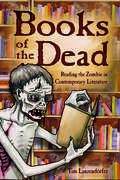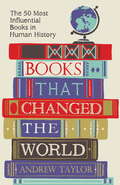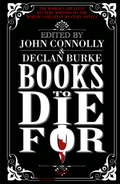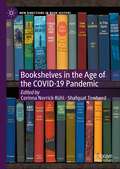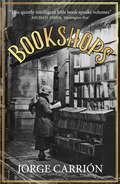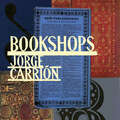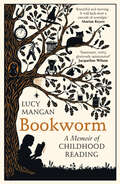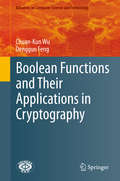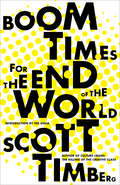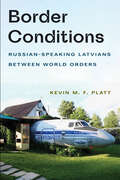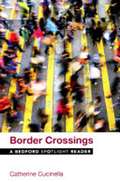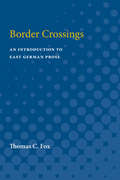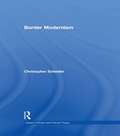- Table View
- List View
Books of the Dead: Reading the Zombie in Contemporary Literature
by Tim LanzendörferThe zombie has cropped up in many forms—in film, in television, and as a cultural phenomenon in zombie walks and zombie awareness months—but few books have looked at what the zombie means in fiction. Tim Lanzendörfer fills this gap by looking at a number of zombie novels, short stories, and comics, and probing what the zombie represents in contemporary literature. Lanzendörfer brings together the most recent critical discussion of zombies and applies it to a selection of key texts including Max Brooks’s World War Z, Colson Whitehead’s Zone One, Junot Díaz’s short story “Monstro,” Robert Kirkman’s comic series The Walking Dead, and Seth Grahame-Smith’s Pride and Prejudice and Zombies. Within the context of broader literary culture, Lanzendörfer makes the case for reading these texts with care and openness in their own right. Lanzendörfer contends that what zombies do is less important than what becomes possible when they are around. Indeed, they seem less interesting as metaphors for the various ways the world could end than they do as vehicles for how the world might exist in a different and often better form.
Books that Changed the World: The 50 Most Influential Books in Human History
by Andrew TaylorBooks that Changed the World tells the fascinating stories behind 50 books that, in ways great and small, have changed the course of human history. Andrew Taylor sets each text in its historical context and explores its wider influence and legacy. Whether he's discussing the incandescent effect of The Qu'ran, the enduring influence of Adam Smith's Wealth of Nations, of the way in which Uncle Tom's Cabin by Harriet Beecher Stowe glavanized the anti-slavery movement, Taylor has written a stirring and informative testament to human ingenuity and endeavour. Ranging from The Iliad to Harry Potter and the Philosopher's Stone, the Kama Sutra to Lady Chatterley's Lover, this is the ultimate, thought-provoking read for book-lovers everywhere.
Books to Die For: The World's Greatest Mystery Writers On The World's Greatest Mystery Novels
by John Connolly Declan BurkeWinner of the 2013 Agatha, Anthony and the Macavity Awards for Best Crime Non-Fiction.With so many mystery novels to choose from and so many new titles appearing each year, where should the reader start? What are the classics of the genre? Which are the hidden gems?In the most ambitious anthology of its kind yet attempted, the world's leading mystery writers have come together to champion the greatest mystery novels ever written. In a series of personal essays that often reveal as much about themselves and their work work as they do about the books that they love, more than 120 authors from twenty countries have created a guide that will be indispensable for generations of readers and writers. From Christie to Child and Poe to PD James, from Sherlock Holmes to Hannibal Lecter and Philip Marlowe to Peter Wimsey, BOOKS TO DIE FOR brings together the cream of the mystery world for a feast of reading pleasure, a treasure trove for those new to the genre and those who believe that there is nothing new left to discover. This is the one essential book for every reader who has ever finished a mystery novel and thought . . . I want more! www.bookstodiefor.net
Bookshelves in the Age of the COVID-19 Pandemic (New Directions in Book History)
by Shafquat Towheed Corinna Norrick-RühlBookshelves in the Age of the COVID-19 Pandemic provides the first detailed scholarly investigation of the cultural phenomenon of bookshelves (and the social practices around them) since the start of the pandemic in March 2020. With a foreword by Lydia Pyne, author of Bookshelf (2016), the volume brings together 17 scholars from 6 countries (Australia, Canada, Germany, the Netherlands, the UK, and the USA) with expertise in literary studies, book history, publishing, visual arts, and pedagogy to critically examine the role of bookshelves during the current pandemic. This volume interrogates the complex relationship between the physical book and its digital manifestation via online platforms, a relationship brought to widespread public and scholarly attention by the global shift to working from home and the rise of online pedagogy. It also goes beyond the (digital) bookshelf to consider bookselling, book accessibility, and pandemic reading habits.
Bookshops
by Jorge Carrión"A lot of people will be interested in the famous bookshops of the world: Jorge Carrión has gone and visited them all. We can't travel right now, but we can travel in books." MARGARET ATWOODWhy do bookshops matter? How do they filter our ideas and literature? In this inventive and highly entertaining extended essay, Jorge Carrion takes his reader on a journey around the world, via its bookshops. His travels take him to Shakespeare & Co in Paris, Wells in Winchester, Green Apple Books in San Francisco, Librairie des Colonnes in Tangier, the Strand Book Store in New York and provoke encounters with thinkers, poets, dreamers, revolutionaries and readers. Bookshops is the travelogue of a lucid and curious observer, filled with anecdotes and stories from the universe of writing, publishing and selling books. A bookshop in Carrion's eyes never just a place for material transaction; it is a meeting place for people and their ideas, a setting for world changing encounters, a space that can transform lives.Written in the midst of a worldwide recession, Bookshops examines the role of these spaces in today's evershifting climate of globalisation, vanishing high streets, e-readers and Amazon. But far from taking a pessimistic view of the future of the physical bookshop, Carrion makes a compelling case for hope, underlining the importance of these places and the magic that can happen there. A vital manifesto for the future of the traditional bookshop, and a delight for all who love them.Translated from the Spanish by Peter Bush
Bookshops
by Jorge CarriónWhy do bookshops matter? How do they filter our ideas and literature? In this inventive and highly entertaining extended essay, Jorge Carrion takes his reader on a journey around the world, via its bookshops. His travels take him to Shakespeare & Co in Paris, Wells in Winchester, Green Apple Books in San Francisco, Librairie des Colonnes in Tangier, the Strand Book Store in New York and provoke encounters with thinkers, poets, dreamers, revolutionaries and readers. Bookshops is the travelogue of a lucid and curious observer, filled with anecdotes and stories from the universe of writing, publishing and selling books. A bookshop in Carrion's eyes never just a place for material transaction; it is a meeting place for people and their ideas, a setting for world changing encounters, a space that can transform lives.Written in the midst of a worldwide recession, Bookshops examines the role of these spaces in today's evershifting climate of globalisation, vanishing high streets, e-readers and Amazon. But far from taking a pessimistic view of the future of the physical bookshop, Carrion makes a compelling case for hope, underlining the importance of these places and the magic that can happen there. A vital manifesto for the future of the traditional bookshop, and a delight for all who love them.(P)2016 WF Howes Ltd
Bookworm: A Memoir of Childhood Reading
by Lucy ManganA love letter to the joys of childhood reading from Wonderland to Narnia.When Lucy Mangan was little, stories were everything. They opened up new worlds and cast light on all the complexities she encountered in this one.She was whisked away to Narnia - and Kirrin Island - and Wonderland. She ventured down rabbit holes and womble burrows into midnight gardens and chocolate factories. She wandered the countryside with Milly-Molly-Mandy, and played by the tracks with the Railway Children. With Charlotte's Web she discovered Death and with Judy Blume it was Boys. No wonder she only left the house for her weekly trip to the library or to spend her pocket money on amassing her own at home.In Bookworm, Lucy revisits her childhood reading with wit, love and gratitude. She relives our best-beloved books, their extraordinary creators, and looks at the thousand subtle ways they shape our lives. She also disinters a few forgotten treasures to inspire the next generation of bookworms and set them on their way.Lucy brings the favourite characters of our collective childhoods back to life - prompting endless re-readings, rediscoveries, and, inevitably, fierce debate - and brilliantly uses them to tell her own story, that of a born, and unrepentant, bookworm.'Passionate, witty, informed, and gloriously opinionated' Jacqueline Wilson author of The Story of Tracy Beaker
Boolean Functions and Their Applications in Cryptography (Advances in Computer Science and Technology #0)
by Chuan-Kun Wu Dengguo FengThis book focuses on the different representations and cryptographic properties of Booleans functions, presents constructions of Boolean functions with some good cryptographic properties. More specifically, Walsh spectrum description of the traditional cryptographic properties of Boolean functions, including linear structure, propagation criterion, nonlinearity, and correlation immunity are presented. Constructions of symmetric Boolean functions and of Boolean permutations with good cryptographic properties are specifically studied. This book is not meant to be comprehensive, but with its own focus on some original research of the authors in the past. To be self content, some basic concepts and properties are introduced. This book can serve as a reference for cryptographic algorithm designers, particularly the designers of stream ciphers and of block ciphers, and for academics with interest in the cryptographic properties of Boolean functions.
Boom Times for the End of the World
by Scott TimbergA rich banquet at the cutting edge of the arts, rooted in California’s eclectic cultural gumbo, by one of America’s most gifted critics, who died young in 2019."A perfect journalistic valediction from one of LA’s finest commentators."—Richard ThompsonThe late Scott Timberg championed artists earnestly and relentlessly, with empathy and persistence. He was a vocal and widely admired advocate for working artists, one of the first to sound the alarm on the escalating economic challenges that have faced creative workers in the twenty-first century. The twenty-six reflections in this book form a valuable window onto many cultural shifts that have upended the country’s creative traditions and expectations. They are, by turns, surprising, wide-ranging, passionate, and fun. Timberg’s perceptive and enthusiastic profiles on the arts extend to West Coast jazz and Gustavo Dudamel’s LA Philharmonic, the fiction of Ray Bradbury and John Rechy, the early films of Spike Jonze and Christopher Nolan, the comics of Los Bros Hernandez and Adrian Tomine, and many more musicians, novelists, filmmakers, architects, and impresarios. Timberg had a knack, as Ted Gioia writes in his introduction, for “finding the best in the cultural scene on the dream coast.” This is an indispensable volume that showcases the author’s endless curiosity, as well as his passion and love for California—especially that confounding and complex metropolis Los Angeles.
Border Conditions: Russian-Speaking Latvians between World Orders (NIU Series in Slavic, East European, and Eurasian Studies)
by Kevin M. PlattBorder Conditions combines history and memory studies with literary and cultural studies to examine lives at the limits of contemporary Europe: Russian speakers living in Latvia. Since the fall of the USSR in 1991, Latvia's Russian speakers have balanced between Russia and Europe as well as a socialist past, a capitalist and liberal present, and an illiberal regime rising in the Russian Federation. Kevin M. F. Platt describes how members of this population have defined themselves through art, literature, cultural institutions, film, and music—and how others have sought to define them. At the end of the Cold War, many anticipated that societies globally could agree on the meaning of past history and a just politics in the present. The view from the borders of Europe demonstrates the contradictions pertaining to terms like empire, state socialism, liberalism, and nation that have made it impossible to achieve a consensus. In refocusing the examination of state socialism's aftermath around questions of empire and postcolonialism, Border Conditions helps us understand the distinctions between Russian and Western worldviews driving military confrontation to this day.
Border Crossings: A Bedford Spotlight Reader
by Catherine CucinellaDelving into questions like, "What are borders?" and "Who are border crossers?", Border Crossings breaks down the complex issue through an extensive variety of readings and activities to really get you thinking and evaluating this theme.
Border Crossings: An Introduction to East German Prose
by Thomas FoxBorder Crossings is an accessible and comprehensive overview of the work of prose fiction writers in what was the German Democratic Republic. Thomas C. Fox introduces readers to the best and most important East German writers—among them Christa Wolf, Jurek Becker, Anna Seghers, Stefan Heym, and Franz Fühmann—restricting his study to work that is available in English translation so that readers who do not know German will be able to read for themselves the literature he discusses.During a period of forty years, writers in the German Democratic Republic struggled with increasing success to free themselves from a smothering and paternalistic governmental embrace, thus anticipating, and helping to constitute, the events of 1989. In its relentless interrogation of the status quo, in its persistent ability to create alternatives, and in its call for more openness, literature in East Germany served as an outlet for energies and ideas that might have been channeled, in the West, into politics, philosophy, or journalism. In addition to discussing the role that literature played in shaping historical events, Fox shows that it can be appreciated simply as literature, outside of its political contexts.
Border Modernism: Intercultural Readings In American Literary Modernism (Literary Criticism and Cultural Theory)
by Christopher SchedlerReorienting the field of American literary modernism, Christopher Schedler defines an intercultural form of representation termed border modernism that challenges the aesthetic hegemony of metropolitan (high) modernism. In this study, Schedler compares the works of European and Anglo-American modernists with the works of Mexican, Native American, and Chicano writers who engaged with modernist theories and practices. In the process he uncovers a unique intercultural aesthetic produced in the borderlands of the United States and Mexico aimed at modernizing the native literary traditions of the Americas. Addressing issues of migration, cultural identity, and ethnography, Border Modernism is a major contribution to current debates over the origins and development of American literary modernism and a new model for transnational and intercultural reconstructions of American literary history.
Border Transgression and Reconfiguration of Caribbean Spaces
by Myriam Moïse Fred RénoA dividing line, the border is usually perceived in terms of separation and rupture. It is a site of tension par excellence, at the origin of contestations, negotiations, and other conflicting patterns of inclusion/exclusion. This book takes us through an exploration of the border in the Caribbean region, both geographically fragmented and strongly tied through its history, culture and people. This collection of scholarly articles interrogates the border within the specificities of the Caribbean context, its socio-political dynamics and its literary and artistic representations. The transgression of borders and the consequent reconfiguring phenomena are thus applied to the Caribbean and its diasporas, through a transdisciplinary approach. The book combines a multiplicity of research fields, including Social Sciences, Cultural Geography, Geopolitics, Cultural and Literary Studies, hence it offers a global perspective on the topic and transcends disciplinary categories. The contents of the book also stretch beyond geographic and linguistic borders as the contributors come from diverse scholarly backgrounds, affiliations, linguistic areas, and research expertise.
Border-Crossing Japanese Literature: Reading Multiplicity (Routledge Contemporary Japan Series)
by Barbara Hartley Akiko UchiyamaThis collection focuses on metaphorical as well as temporal and physical border-crossing in writing from and about Japan. With a strong consciousness of gender and socio-historic contexts, contributors to the book adopt an intercultural and interdisciplinary approach to examine the writing of authors whose works break free from the confines of hegemonic Japanese literary endeavour. By demonstrating how the texts analysed step outside the space of ‘Japan’, they accordingly foreground the volatility of textual expression related to that space. Authors discussed include Takahashi Mutsuo and Nagai Kafū, both of whom take literary inspiration from geographical sites outside Japan Several chapters examine the work of exemplar border-crossing poet, novelist and essayist, Itō Hiromi. There are discussions of the work of Tawada Yōko whose ability to publish in German and Japanese marks her also as a representative writer of border-crossing texts. Two chapters address works by Murakami Haruki who, although clearly affiliating with western cultural form, is rarely discussed in specific border-crossing terms. The chapter on Ainu narratives invokes topics such as translation, indigeneity and myth, while an analysis of Japanese prisoner of war narratives notes the language and border-crossing nexus. A vital collection for scholars and students of Japanese literature.
Border-Line Personalities: A New Generation of Latinas Dish on Sex, Sass, & Cultural Shifting
by Robyn Moreno and Michelle Herrera MulliganA collection of essays from some of the best writers in America, about what it means to be a fully functional, and sometimes fully dysfunctional, 21st–century, born–in–the–USA LatinaTired of the trite cultural clichés by which the media has defined Latinas, the editors of this collection of personal essays by both established and emerging authors, have gathered them with the intention of representing their varied experiences, through hilarious anecdotes from each of their colorful lives. While there is no one Latina identity, the editors believe that by offering a glimpse into these writers’ dynamic lives, they will facilitate a better understanding of their unique challenges and their dreams, and most important, their oftentimes shared histories.The contributors to this collection mirror the compassionate pleas Latinas usually reserve for each other over conversations in dark bars and late night gatherings. “Do they have to think that just because I’m a Latina that I can speak Spanish, curl my hair, paint my toe nails, and dance a rumba--all at the same time?” This, along with other interesting questions, results in a spectacular line up that has Latinas musing on their battling the world, the men that have done them wrong, and of course the mothers who, more often than not, just never understood that their daughters were more Americanas than not.
Bordering Tibetan Languages: Making and Marking Languages in Transnational High Asia (Asian Borderlands)
by Gerald Roche Gwendolyn HyslopBordering Tibetan Languages: Making and Marking Languages in Transnational High Asia examines the complex interactions between state, ethnic, and linguistic borders in the Himalayas. These case studies from Bhutan, China, India, and Nepal show how people in the Himalayas talk borders into existence, and also how those borders speak to them and their identities. These ‘talking borders’ exist in a world where state borders are contested, and which is being irrevocably transformed by rapid social and economic change. This book offers a new perspective on this dynamic region by centring language, and in doing so, also offers new ways of thinking about how borders and language influence each other.
Borderland Capitalism: Turkestan Produce, Qing Silver, and the Birth of an Eastern Market
by Kwangmin KimScholars have long been puzzled by why Muslim landowners in Central Asia, called begs, stayed loyal to the Qing empire when its political legitimacy and military power were routinely challenged. Borderland Capitalism argues that converging interests held them together: the local Qing administration needed the Turkic begs to develop resources and raise military revenue while the begs needed access to the Chinese market. Drawing upon multilingual sources and archival material, Kwangmin Kim shows how the begs aligned themselves with the Qing to strengthen their own plantation-like economic system. As controllers of food supplies, commercial goods, and human resources, the begs had the political power to dictate the fortunes of governments in the region. Their political choice to cooperate with the Qing promoted an expansion of the Qing's emerging international trade at the same time that Europe was developing global capitalism and imperialism. Borderland Capitalism shows the Qing empire as a quintessentially early modern empire and points the way toward a new understanding of the rise of a global economy.
Borders Revisited: Discourses on the UK Border (Migration, Diasporas and Citizenship)
by Bastian A. VollmerThe nature and configuration of borders, and the relationship between state borders and societies, have changed. In the 21st century, internationalism, transnationalism, and super-diversity have further provoked complexities and anxieties. It seems that as border and migration regimes undergo dramatic transformations, their public profile increases.This book revisits borders, bordering practices, and meanings, with a particular focus on the United Kingdom as a case study. Bastian A. Vollmer examines not only the theoretical and historical dimensions of borders but also various empirical data, including extensive text corpora and dozens of in-depth interviews. Expanding on the concept of vernacular security—that is, an everyday understanding of security—he argues that the existential value of borders is not merely physical, but extends into the order and future construction of states and societies.This book demonstrates decisively that the concept of the border has not left the centre stage of philosophy, political theory, and political sociology, but has instead emerged as a focal point for multidisciplinary engagements. It further demonstrates how attention to a vernacular perspective can inform those engagements, yielding vital insights. As such, it should appeal to students and scholars across disciplines interested in the contemporary development and relevance of borders and their discursive cultures.
Borders and Border Crossings in the Contemporary British Short Story
by Barbara Korte Laura Mª Lojo-RodríguezThis book represents a contribution to both border studies and short story studies. In today’s world, there is ample evidence of the return of borders worldwide: as material reality, as a concept, and as a way of thinking. This collection of critical essays focuses on the ways in which the contemporary British short story mirrors, questions and engages with border issues in national and individual life. At the same time, the concept of the border, as well as neighbouring notions of liminality and intersectionality, is used to illuminate the short story’s unique aesthetic potential. The first section, “Geopolitics and Grievable Lives”, includes chapters that address the various ways in which contemporary stories engage with our newly bordered world and borders within contemporary Britain. The second section examines how British short stories engage with “Ethnicity and Liminal Identities”, while the third, “Animal Encounters and Metamorphic Bodies”, focuses on stories concerned with epistemological borders and borderlands of existence and identity. Taken together, the chapters in this volume demonstrate the varied and complex ways in which British short stories in the twenty-first century engage with the concept of the border.
Borders, Boundaries, and Frames (Essays from the English Institute)
by Mae G. HendersonThe essays in this volume take up the challenge of working out -- or reworking -- the problematics of the borders, the boundaries and the frameworks that structure our various and multiple notions of identity -- textual, personal, collective, generic, and disciplinary. The contributors to this volume write about subjects (and are often themselves subjects) who "refuse to occupy a single territory" -- who cross geographical, cultural, national, linguistic, generic, specular and disciplinary borders. Essays by Kathryn Hellerstein, Anita Goldman, Jane Marcus and Scott Malcomson exlpore the semiotics of exile and the problem of its representation in the lives and writings of individual aritists and intellectuals. Autobiographical criticism, as represented in the essays by Nancy Miller and Sara Suleri, enlargess our conventional notions of what consitutes literature in general and criticism in particular.
Borderwaters: Amid the Archipelagic States of America
by Brian Russell RobertsConventional narratives describe the United States as a continental country bordered by Canada and Mexico. Yet, since the late twentieth century the United States has claimed more water space than land space, and more water space than perhaps any other country in the world. This watery version of the United States borders some twenty-one countries, particularly in the archipelagoes of the Pacific and the Caribbean. In Borderwaters Brian Russell Roberts dispels continental national mythologies to advance an alternative image of the United States as an archipelagic nation. Drawing on literature, visual art, and other expressive forms that range from novels by Mark Twain and Zora Neale Hurston to Indigenous testimonies against nuclear testing and Miguel Covarrubias's visual representations of Indonesia and the Caribbean, Roberts remaps both the fundamentals of US geography and the foundations of how we discuss US culture.
Borderwork: Feminist Engagements with Comparative Literature (Reading Women Writing)
The first book to assess the impact of feminist criticism on comparative literature, Borderwork recharts the intellectual and institutional boundaries on that discipline. The seventeen essays collected here, most published for the first time, together call for the contextualization of the study of comparative literature within the areas of discourse, culture, ideology, race, and gender. Contributors: Bella Brodzki, VèVè A. Clark, Chris Cullens, Greta Gaard, Sabine Gölz, Sarah Webster Goodwin, Margaret R. Higonnet, Marianne Hirsch, Susan Sniader Lanser, Françoise Lionnet, Fedwa Malti-Douglas, Lore Metzger, Nancy K. Miller, Obioma Nnaemakea, Rajeswari Sunder Rajan, Anca Vlasopolos.
Boredom in the Foreign Language Classroom: A Micro-Perspective (Second Language Learning and Teaching)
by Mirosław Pawlak Joanna Zawodniak Mariusz KrukThe book focuses on boredom, a construct that has been explored in educational psychology but has received only scant attention from second language acquisition researchers. Although recent years have seen a growing interest in positive emotions in second or foreign language learning and teaching, negative emotions are always present in the classroom and they deserve to be investigated in their own right. The theoretical part provides an overview of the construct of boredom (e.g., definitions, types, empirical studies in the L2 classroom). The empirical part reports the findings of an empirical study which aimed to examine the changes in the levels of boredom experienced by a group of English majors in English classes and identify the factors accounting for such changes. The book closes with a discussion of directions for further research as well as some pedagogic implications.
Borges Beyond the Visible
by Max Ubelaker AndradeBorges Beyond the Visible presents radically new readings of some of Jorge Luis Borges’s most celebrated stories. Max Ubelaker Andrade shows how Borges employed intertextual puzzles to transform his personal experiences with blindness, sexuality, and suicide while allowing readers to sense the transformative power of their own literary imaginations.In readings of "Tlön, Uqbar, Orbis Tertius," "El Aleph," and "El Zahir," Ubelaker Andrade argues that Borges, considering his own impending blindness, borrowed from Islam’s prohibitions on visual representation to create a "literary theology"—a religion focused on the contradictions of literary existence and the unstable complexities of a visual world perceived without everyday sight. Embracing these contradictions allowed Borges to transform his relationships with sex, sexuality, and family in multilayered stories such as "Emma Zunz," "La intrusa," and "El jardín de senderos que se bifurcan." Yet these liberating transformations, sometimes offered to the reader as a paradoxical "gift of death," are complicated by "La salvación por las obras," a story built around Borges’s relationship with a suicidal reader and the woman to whom they were both connected. The epilogue presents "Místicos del Islam," an unpublished essay draft by Borges, as a key source of insight into an irreverent, iconoclastic writing practice based on a profound faith in fiction.Compelling and clear, Borges Beyond the Visible is a revelatory examination of the work of one of the most influential authors of the twentieth century. It opens up exciting areas of inquiry for scholars, students, and readers of Borges.
